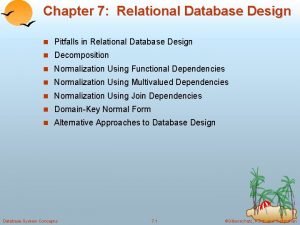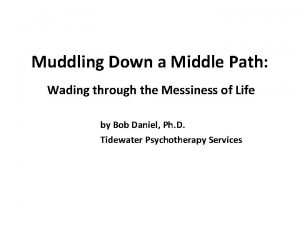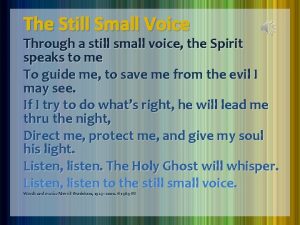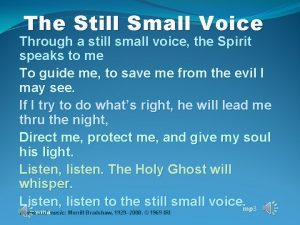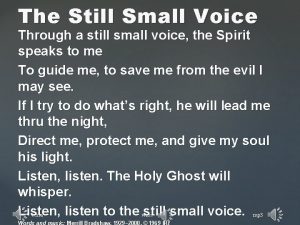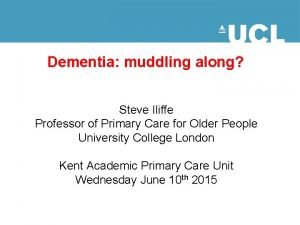Deinstitutionalization Still muddling not yet through Goals Pitfalls






![Cost implications of keeping institutions p. 7 [optional footer] Cost implications of keeping institutions p. 7 [optional footer]](https://slidetodoc.com/presentation_image_h/01f48b4c4d0a14417f3d875fa721a655/image-7.jpg)









![Bulgaria Children in care 9000 8000 7000 8035 [VALUE] 6730 6000 [VALUE] 5000 6442 Bulgaria Children in care 9000 8000 7000 8035 [VALUE] 6730 6000 [VALUE] 5000 6442](https://slidetodoc.com/presentation_image_h/01f48b4c4d0a14417f3d875fa721a655/image-17.jpg)


![Thank you ! p. 20 [optional footer] Thank you ! p. 20 [optional footer]](https://slidetodoc.com/presentation_image_h/01f48b4c4d0a14417f3d875fa721a655/image-20.jpg)
- Slides: 20

Deinstitutionalization – “Still muddling, not yet through” Goals, Pitfalls, Learning, Challenges Radostina Paneva Andro Dadiani SOS Children`s Villages International p. 1 [optional footer]

Deinstitutionalization (De-I) is: § Decreasing reliance on institutional and residential care with a complementary increase in family- and community-based care and services; § Preventing separation of children from their parents by providing adequate support to children, families and communities; § Preparing the process of leaving care, ensuring social inclusion for care leavers and a smooth transition towards independent living. De-I is systematic policy implementation not just sporadic projects p. 2 [optional footer]

Timeframes of Reform Processes Latvia UN CRC Ratification 1992 Bulgaria “Social Services and Social Assistance law” (2002 CPC and first steps of child care reform 2000 UN CRC 1991 UN CRC ratification 1997 Georgia p. 3 Approved De-I plan 2015 De-I Strategy and Plan approved 2010 Launch of De-I processes 2000 Reduction of number of children to 24 in 3 group of 8 201 Closed all institutions for children with disabilities – 2016 First De-I action plan 2005 -07 Only 800 children to remain in institutional care by 2023 All institutions to be closed by 2025 Closure of all (49) but 2 state institutions 2013 Last “wave of De-I” 2015 [optional footer]

Lithuania as seen from the outside § UN CRC concluding observations (CRC/C/LTU/CO/3 -4, 4 October 2013) • The large number of cases of deprivation of parental rights and placement of children, in particular children under the age of 3, in care institutions; • Very low number of foster families and inadequate support provided to them; • Lack of monitoring system of non-governmental children’s homes which often fail to comply with the legal requirements for hygiene, quality of services and space p. 4 [optional footer]

Management of the De-I process § Challenges • Clarity of plans and their timeframes • Division of roles and responsibilities between various agencies responsible for • • children’s issues Monitoring and evaluation Communication of De-I goals and progress of reforms to stakeholders and wider public § Lesson learned • Changing of legislation are essential (with regards to rights, services, finance) • Leaders within the country championing De-I processes • Regular monitoring and modification of plans • Closure of institutions should be an important planned milestone • Less developed services for prevention and reintegration = no decrease of children in formal care p. 5 Plans are often developed “under conditions of maximum ignorance and minimum experience” [optional footer]

Financial mechanisms – Key issues § Comparing the cost of institutional care and community-based services • • Currently provided care which is free to the state in reality is a hidden cost, paid by external donors Economic implications § Ring-fencing the current volume of funding § Initial investment for starting up the needed services § Costs must be based on, and reflective of the structure of specific services p. 6 [optional footer]
![Cost implications of keeping institutions p 7 optional footer Cost implications of keeping institutions p. 7 [optional footer]](https://slidetodoc.com/presentation_image_h/01f48b4c4d0a14417f3d875fa721a655/image-7.jpg)
Cost implications of keeping institutions p. 7 [optional footer]

Service development – key issues • • Financing of services Regulation of services Variety of available alternatives Flexibility of existing services to address the emerging needs of children Understanding that new quality services should be cheaper than institutions in short term period p. 8 [optional footer]

Examples: Georgia § Emergency foster care ensured that all new referrals to child protection system were diverted to family based care § Foster care – main family substitute care alternative § SGHs – a service used for sibling groups, older children (variety of models) § Specialized SGHs (e. g. for children with severe disabilities) § 1424 Children in Foster Care – o/w 210 children with disabilities § 352 Children in SGHs – o/w 7 in specialized SGH § 387 Children in large scale residential care (in 2 State run and 2 Church run institutions) § Per/capita amount of financing in FC and SGH are the same although financing modality very different p. 9 [optional footer]

Community based services INSTITUTIONAL CARE Support in a family • Prevention services • Reintegration • Kinship care • Guardianship (with an extended family or family friends) • Adoption Alternative care • Foster Care • Small group homes Support services needed by all children: - Medical services - Education services - Social services - Universal services for all children not just the ones at risk ones p. 10 [optional footer]

Workforce § Staff of the old institutions § Staff of the new community based services, especially SGHs § Professionalization of the staff § Staff turnover and regular support § Foster care givers p. 11 [optional footer]

New placements – key issues § Thorough assessment of children § Stability/permanency of the placement § Scrupulous preparation of a child for a new placement § Placement dilemma: close to the family or close to the services? § Referral mechanisms Child is not a number in the statistics p. 12 [optional footer]

Children and Families’ Support services § § § § Centers for community support Day care centers Short term/emergency care placement Crises centers Mother and baby centers Integrated services for early childhood development Day care centers for children with severe mental disorders § Integrated social – health services § Universal services for all children p. 13 [optional footer]

Small group homes § § Number of children in the service Target group Professionals working in SGH ( various options) Standards for physical environment = standards connected with quality of life § Coordination between social and health and education systems (for children with special needs) Residential care or small institutions p. 14 [optional footer]

Foster care Services for a child Services for foster families Child and risks assessment Recruiting foster families Child leaves foster care Child is cared for by foster family Child at risk Formal placement in foster family p. 15 Decision to place in foster care Foster family retires or withdraws Matching with suitable foster family Support and development of foster families Assessment and training Child at risk Accreditation of foster families Matching and first placement [optional footer]

Children in institutional care as % of child population § Lithuania – (3276) 0. 58 % § Latvia – (1218) 0. 31% § Bulgaria - (1050) 0. 08% § Georgia – (387) 0. 04% p. 16 [optional footer]
![Bulgaria Children in care 9000 8000 7000 8035 VALUE 6730 6000 VALUE 5000 6442 Bulgaria Children in care 9000 8000 7000 8035 [VALUE] 6730 6000 [VALUE] 5000 6442](https://slidetodoc.com/presentation_image_h/01f48b4c4d0a14417f3d875fa721a655/image-17.jpg)
Bulgaria Children in care 9000 8000 7000 8035 [VALUE] 6730 6000 [VALUE] 5000 6442 6076 5796 5658 4755 4122 4000 3578 3000 2112 1943 2000 1000 0 p. 17 [VALUE] 885 420 0 2009 885 384 0 2010 885 436 0 2011 2721 2275 1144 530 0 2012 602 0 2013 612 560 275 2014 Children in institutions Children in foster care Adults in children`s institutions Adults in SGHs Children in SGH Total in Care 2908 1050 2016 [optional footer]

Bulgaria Professional foster care was established in Bulgaria in the framework of a 3 year state project (2012 -2014) “I have a family too” financed by the EU, operative programme “Human Resources”. It was implemented in 83 municipalities. Total budget - 10 500 000 EUR. (2015) ; 202 Results (31. 01. 2016): § 2220 foster families in total § 2206– professional foster families. § Number of children in foster families – 3195 children; 5% children with disabilities. • • • p. 18 80 % coming from families 12 % from institutions 8 % SGH [optional footer]

Examples: Bulgaria Professional foster care: Foster parents receive the same as above monthly allowances per child plus financial compensation for their work. § For one child in care: 435 BGN/217 euro per month/child and this is 150% of minimum salary in the country; § For 2 children in care: 464 BGN/232 euro per month/child and this is 160% of minimum salary in the country; § For 3 children and more in care: 493 BGN/247 euro per month/child and this is 170% of minimum salary in the country. § Financial standard for the service “foster care” including support services for foster parents and children is under development. p. 19 [optional footer]
![Thank you p 20 optional footer Thank you ! p. 20 [optional footer]](https://slidetodoc.com/presentation_image_h/01f48b4c4d0a14417f3d875fa721a655/image-20.jpg)
Thank you ! p. 20 [optional footer]
 Lindblom science of muddling through
Lindblom science of muddling through Still not there yet
Still not there yet Strategic goals tactical goals operational goals
Strategic goals tactical goals operational goals Strategic goals tactical goals operational goals
Strategic goals tactical goals operational goals Eliminating muddling mindset
Eliminating muddling mindset Who said i have not yet begun to fight
Who said i have not yet begun to fight Literary devices in macbeth quotes
Literary devices in macbeth quotes Romeo and juliet timeline day by day
Romeo and juliet timeline day by day Hear me i am not the man i was
Hear me i am not the man i was Yet not to thine eternal resting place
Yet not to thine eternal resting place If not yet done
If not yet done Jeopardylabs past simple
Jeopardylabs past simple Sudden and violent but brief; fitful; intermittent
Sudden and violent but brief; fitful; intermittent General goals and specific goals
General goals and specific goals Motivation in consumer behaviour
Motivation in consumer behaviour Circuit pitfalls in vlsi
Circuit pitfalls in vlsi Discuss pitfalls in differentiation.
Discuss pitfalls in differentiation. What are two pitfalls (problems) of lock-based protocols
What are two pitfalls (problems) of lock-based protocols Common pitfalls adalah
Common pitfalls adalah Pitfalls in relational database design geeksforgeeks
Pitfalls in relational database design geeksforgeeks Graph based locking protocol
Graph based locking protocol



















